Procter & Gamble Bundle
How Did a Soap and Candle Partnership Become a Global Giant?
Imagine a company that started with simple household essentials and now touches billions of lives daily. Procter & Gamble, a name synonymous with everyday products, began its journey in 1837 in Cincinnati, Ohio. From its humble beginnings, P&G has grown into a multinational powerhouse, shaping the consumer goods landscape as we know it.
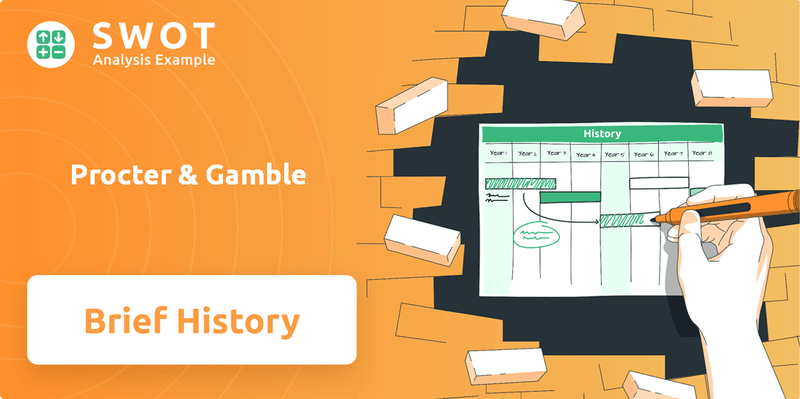
The Procter & Gamble SWOT Analysis reveals the strategic depth of this consumer goods giant. The story of Procter & Gamble company is a testament to innovation and adaptability. This article delves into the P&G history, exploring its early days, company timeline, and the pivotal moments that transformed it into a global leader. From its founding in Cincinnati Ohio, to its current global presence, discover how P&G has consistently met the evolving needs of consumers.
What is the Procter & Gamble Founding Story?
The story of Procter & Gamble, or P&G, began in Cincinnati, Ohio. It was formally established on August 22, 1837. This marked the beginning of a company that would become a global leader in the consumer goods industry.
The founders, William Procter and James Gamble, were brought together by family ties. Their shared vision and the circumstances of the time laid the groundwork for a business that would endure for over a century. Understanding the Marketing Strategy of Procter & Gamble is key to appreciating its longevity.
The early days of Procter & Gamble involved making and selling essential household items. This simple start set the stage for the company's future growth and its significant impact on the consumer market.
Procter & Gamble was formed on August 22, 1837, in Cincinnati, Ohio.
- William Procter, a candlemaker, and James Gamble, a soapmaker, founded the company.
- They were brought together through their marriages to sisters.
- Their father-in-law suggested the business partnership.
- The initial focus was on soap and candles.
Procter & Gamble SWOT Analysis
- Complete SWOT Breakdown
- Fully Customizable
- Editable in Excel & Word
- Professional Formatting
- Investor-Ready Format
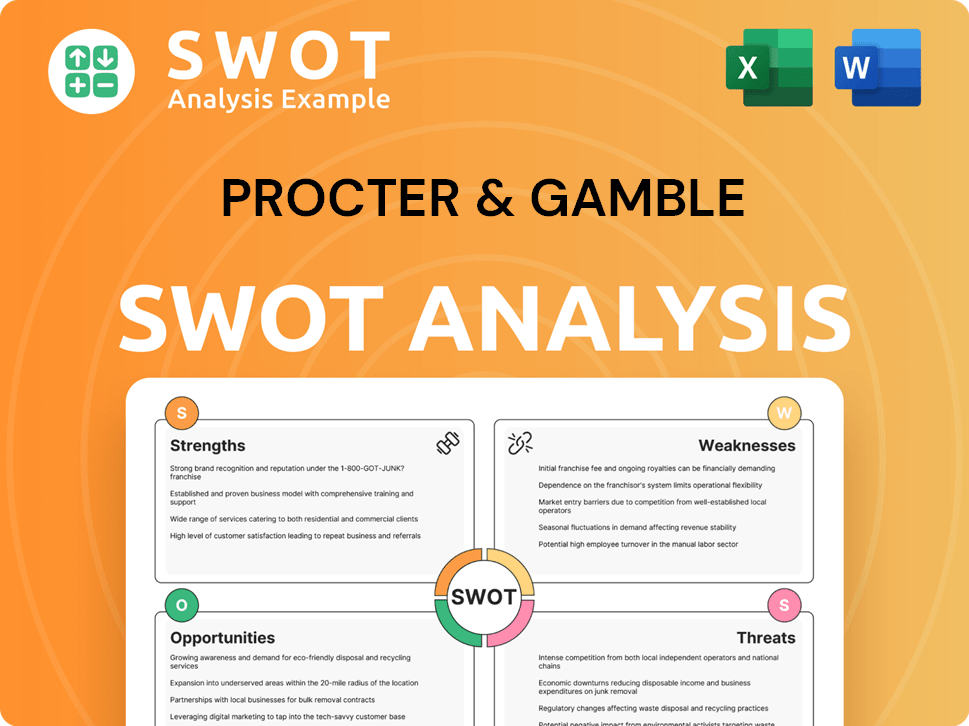
What Drove the Early Growth of Procter & Gamble?
The early growth of Procter & Gamble, or P&G, was marked by a strong emphasis on product quality and innovation. By the 1850s, the company had achieved a significant milestone, with annual sales reaching $1 million. The Civil War was a critical period for the company, leading to substantial growth.
During the Civil War, P&G secured contracts to supply soap and candles to the Union Army. This boosted production and expanded the reach of its products across the nation. Securing these contracts was a pivotal moment in the P&G history, significantly impacting its trajectory.
In 1879, P&G introduced 'Ivory' soap, a groundbreaking product that floated. This innovation gained immense popularity and became one of P&G's first iconic brands. The success of Ivory soap solidified P&G's position in the consumer goods market.
The late 19th and early 20th centuries saw P&G enter new product categories and expand its market presence. The introduction of Crisco, the first all-vegetable shortening in 1911, diversified its portfolio beyond soap and candles. This strategic move broadened its appeal to consumers.
P&G pioneered market research and brand management, understanding consumer needs and building distinct brand identities. Early team expansion focused on sales and manufacturing, with production facilities expanding beyond Cincinnati, Ohio. This focus on understanding consumers was key.
Procter & Gamble PESTLE Analysis
- Covers All 6 PESTLE Categories
- No Research Needed – Save Hours of Work
- Built by Experts, Trusted by Consultants
- Instant Download, Ready to Use
- 100% Editable, Fully Customizable
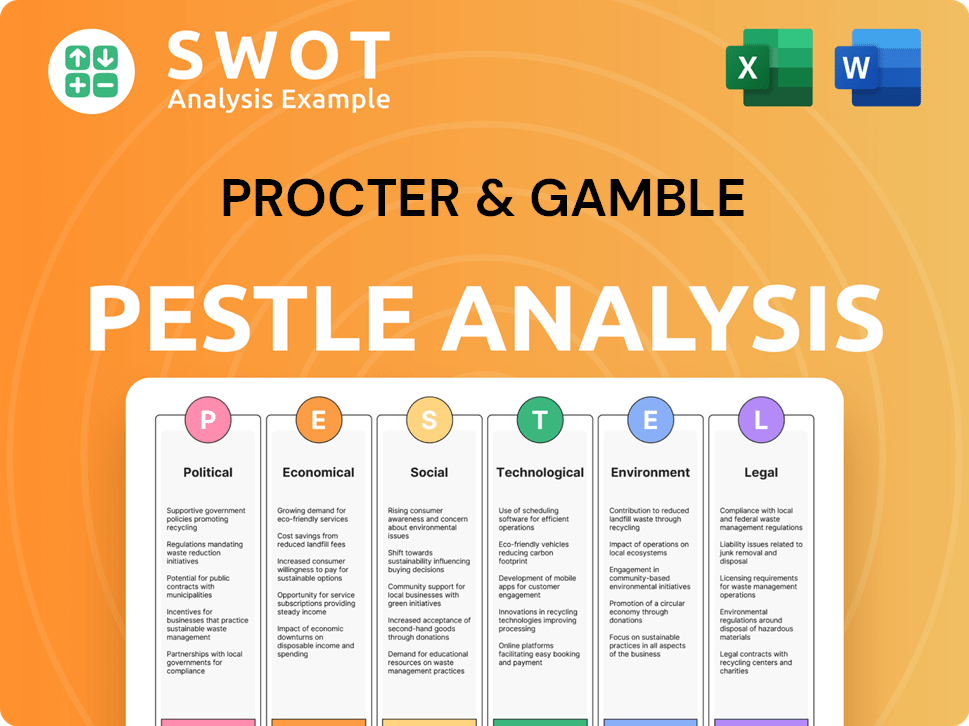
What are the key Milestones in Procter & Gamble history?
The Procter & Gamble company, a cornerstone of the consumer goods industry, has a rich history marked by significant milestones. From its humble beginnings in Cincinnati, Ohio, to its global presence today, P&G's journey reflects a commitment to innovation and adaptation.
| Year | Milestone |
|---|---|
| 1837 | William Procter and James Gamble founded Procter & Gamble in Cincinnati, Ohio, initially producing candles and soap. |
| 1879 | Ivory soap was introduced, becoming a landmark product known for its purity and ability to float. |
| 1946 | Tide laundry detergent was launched, revolutionizing the laundry industry with its superior cleaning capabilities. |
| 1955 | Crest toothpaste, a major product in oral hygiene, was introduced, marking a significant expansion into the health sector. |
| 1961 | Pampers diapers were introduced, changing the baby care market. |
| 1985 | P&G acquired Richardson-Vicks, expanding its portfolio with brands like Vicks and Oil of Olay. |
| 2014 | P&G announced a plan to streamline its brand portfolio, focusing on its most profitable and high-growth brands. |
Procter & Gamble's commitment to innovation is evident in its product development and marketing strategies. The company has consistently pioneered new product categories and improved existing ones, driving consumer preferences and market trends.
The introduction of Ivory soap in 1879, with its unique floating characteristic, set a new standard in the soap market. This innovation demonstrated the company's focus on product differentiation and consumer appeal.
Launched in 1946, Tide quickly became a leading laundry detergent due to its effective cleaning power, reshaping the laundry industry. Tide's success highlighted P&G's ability to create superior products.
P&G pioneered the concept of brand management, assigning dedicated teams to individual brands. This strategy allowed for focused marketing and product development, enhancing brand equity and market share.
The introduction of Pampers in 1961 revolutionized the baby care market, offering a convenient and effective solution for parents. Pampers became a leading brand in the disposable diaper category.
Crest toothpaste, introduced in 1955, was a significant innovation in oral hygiene. Crest's focus on cavity prevention helped establish it as a trusted brand.
P&G consistently invests in research and development, leading to numerous patents across various product categories. This commitment to innovation ensures a steady stream of new products and improvements.
Despite its successes, the Procter & Gamble company has faced various challenges throughout its history. Economic downturns, intense competition, and market shifts have required the company to adapt and evolve its strategies.
Economic recessions have impacted consumer spending, requiring P&G to adjust pricing and marketing strategies. The company has focused on value and affordability to maintain market share.
Intense competition from both established rivals and emerging brands has forced P&G to innovate and differentiate its products. P&G has responded with strategic acquisitions and brand portfolio adjustments.
P&G has experienced product failures, which have led to financial losses and reputational damage. The company has learned from these experiences, emphasizing consumer insights and rigorous testing.
Changing consumer preferences and market trends have required P&G to adapt its product development and marketing approaches. The company has focused on sustainability and health-conscious products.
P&G has undergone significant restructuring and divestitures to streamline operations and focus on high-growth categories. This has allowed the company to improve efficiency and profitability.
Fluctuations in global economic conditions, including inflation and currency exchange rates, have presented challenges. P&G has managed these challenges through hedging strategies and localized pricing.
Procter & Gamble Business Model Canvas
- Complete 9-Block Business Model Canvas
- Effortlessly Communicate Your Business Strategy
- Investor-Ready BMC Format
- 100% Editable and Customizable
- Clear and Structured Layout
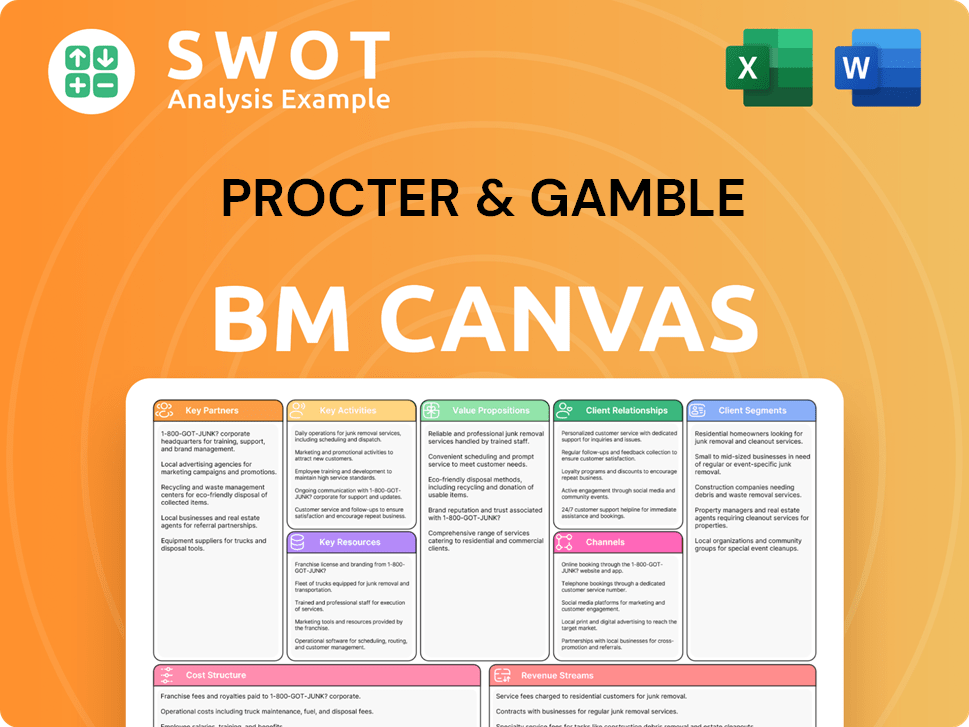
What is the Timeline of Key Events for Procter & Gamble?
The story of Procter & Gamble's journey, from its humble beginnings in Cincinnati, Ohio, to its current status as a global consumer goods giant, is a testament to strategic innovation and market adaptation. The
P&G history
is marked by pivotal moments, including the launch of iconic products and strategic acquisitions that have shaped its trajectory. ThisProcter & Gamble company
timeline highlights key milestones in its evolution.| Year | Key Event |
|---|---|
| 1837 | William Procter and James Gamble establish Procter & Gamble in Cincinnati, Ohio, laying the foundation for the company. |
| 1879 | Ivory soap, the 'soap that floats,' is introduced, marking a significant early product innovation. |
| 1911 | Crisco, the first all-vegetable shortening, is launched, expanding the company's product offerings. |
| 1946 | Tide laundry detergent is introduced, revolutionizing the laundry industry with its effective cleaning power. |
| 1955 | Crest toothpaste, with fluoride, is launched, entering the oral care market and improving dental health. |
| 1961 | Pampers disposable diapers are introduced, transforming baby care practices globally. |
| 1985 | Acquisition of Richardson-Vicks, adding brands like Vicks and Olay to the portfolio. |
| 2005 | Acquisition of Gillette, significantly expanding P&G's grooming and oral care portfolio. |
| 2014-2016 | Major portfolio restructuring, divesting numerous brands to focus on core categories and streamline operations. |
| 2020-2025 | Continued focus on e-commerce, sustainable innovation, and personalized consumer experiences, adapting to evolving consumer behaviors. |
P&G is heavily investing in sustainable practices to reduce its environmental footprint. The company is working on eco-friendly product development, including packaging and ingredients. This effort aligns with consumer demand for more sustainable options, which is a growing trend. For instance, P&G aims to reduce its greenhouse gas emissions by 50% by 2030.
E-commerce and data analytics are key areas of focus for
Procter & Gamble
. The company is enhancing its online presence to meet changing consumer preferences, with online sales contributing significantly to overall revenue. Data analytics are used to personalize consumer experiences. In fiscal year 2023, e-commerce sales accounted for approximately 16% of P&G's total sales.P&G is strategically expanding its presence in high-growth markets. The company is focusing on premiumization and health & wellness categories to meet evolving consumer needs. This includes adapting products to local preferences and leveraging diverse distribution channels. In 2024, P&G's growth strategy includes expanding in Asia.
The company emphasizes agility and delivering superior consumer value through its iconic brands. This approach is rooted in the founders' vision of providing high-quality products.
Procter & Gamble
continues to adapt to changing market dynamics. Despite economic challenges, P&G has demonstrated resilience, with a focus on innovation and consumer satisfaction.Procter & Gamble Porter's Five Forces Analysis
- Covers All 5 Competitive Forces in Detail
- Structured for Consultants, Students, and Founders
- 100% Editable in Microsoft Word & Excel
- Instant Digital Download – Use Immediately
- Compatible with Mac & PC – Fully Unlocked
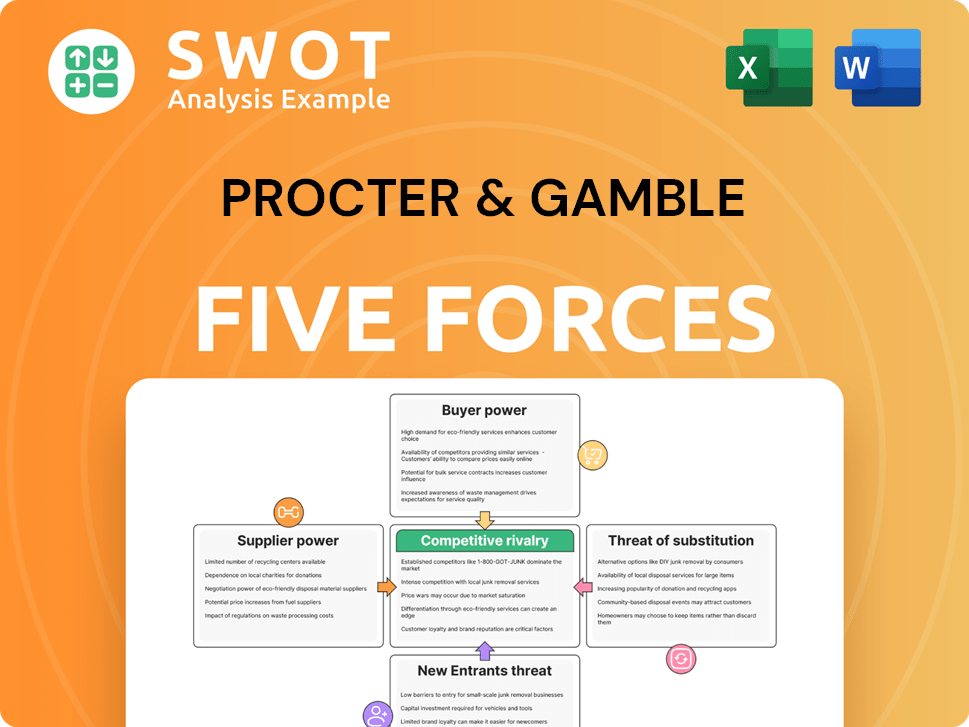
Related Blogs
- What is Competitive Landscape of Procter & Gamble Company?
- What is Growth Strategy and Future Prospects of Procter & Gamble Company?
- How Does Procter & Gamble Company Work?
- What is Sales and Marketing Strategy of Procter & Gamble Company?
- What is Brief History of Procter & Gamble Company?
- Who Owns Procter & Gamble Company?
- What is Customer Demographics and Target Market of Procter & Gamble Company?
Disclaimer
All information, articles, and product details provided on this website are for general informational and educational purposes only. We do not claim any ownership over, nor do we intend to infringe upon, any trademarks, copyrights, logos, brand names, or other intellectual property mentioned or depicted on this site. Such intellectual property remains the property of its respective owners, and any references here are made solely for identification or informational purposes, without implying any affiliation, endorsement, or partnership.
We make no representations or warranties, express or implied, regarding the accuracy, completeness, or suitability of any content or products presented. Nothing on this website should be construed as legal, tax, investment, financial, medical, or other professional advice. In addition, no part of this site—including articles or product references—constitutes a solicitation, recommendation, endorsement, advertisement, or offer to buy or sell any securities, franchises, or other financial instruments, particularly in jurisdictions where such activity would be unlawful.
All content is of a general nature and may not address the specific circumstances of any individual or entity. It is not a substitute for professional advice or services. Any actions you take based on the information provided here are strictly at your own risk. You accept full responsibility for any decisions or outcomes arising from your use of this website and agree to release us from any liability in connection with your use of, or reliance upon, the content or products found herein.